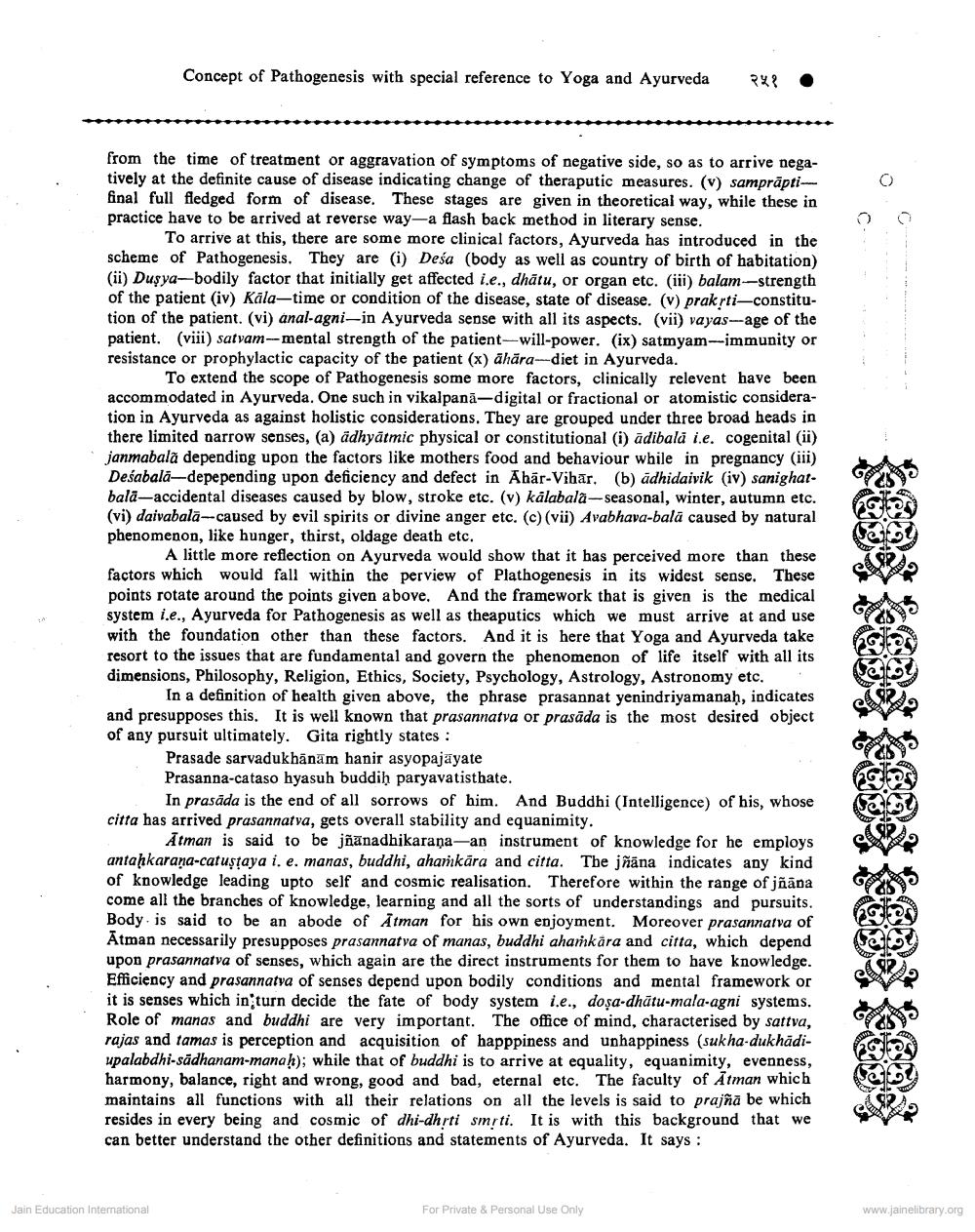________________
Concept of Pathogenesis with special reference to Yoga and Ayurveda २५१
from the time of treatment or aggravation of symptoms of negative side, so as to arrive negatively at the definite cause of disease indicating change of theraputic measures. (v) samprāptifinal full fledged form of disease. These stages are given in theoretical way, while these in practice have to be arrived at reverse way-a flash back method in literary sense.
To arrive at this, there are some more clinical factors, Ayurveda has introduced in the scheme of Pathogenesis. They are (i) Desa (body as well as country of birth of habitation) (ii) Duşya-bodily factor that initially get affected i.e., dhātu, or organ etc. (iii) balam--strength of the patient (iv) Kala-time or condition of the disease, state of disease. (v) prakṛti-constitution of the patient. (vi) anal-agni-in Ayurveda sense with all its aspects. (vii) vayas--age of the patient. (viii) satvam-mental strength of the patient-will-power. (ix) satmyam-immunity or resistance or prophylactic capacity of the patient (x) āhāra-diet in Ayurveda.
To extend the scope of Pathogenesis some more factors, clinically relevent have been accommodated in Ayurveda. One such in vikalpana-digital or fractional or atomistic consideration in Ayurveda as against holistic considerations. They are grouped under three broad heads in there limited narrow senses, (a) adhyatmic physical or constitutional (i) adibala i.e. cogenital (ii) janmabală depending upon the factors like mothers food and behaviour while in pregnancy (iii) Deśabala-depepending upon deficiency and defect in Ahär-Vihar, (b) adhidaivik (iv) sanighatbala-accidental diseases caused by blow, stroke etc. (v) kalabala-seasonal, winter, autumn etc. (vi) daivabala-caused by evil spirits or divine anger etc. (c) (vii) Avabhava-bala caused by natural phenomenon, like hunger, thirst, oldage death etc.
A little more reflection on Ayurveda would show that it has perceived more than these factors which would fall within the perview of Plathogenesis in its widest sense. These points rotate around the points given above. And the framework that is given is the medical system i.e., Ayurveda for Pathogenesis as well as theaputics which we must arrive at and use with the foundation other than these factors. And it is here that Yoga and Ayurveda take resort to the issues that are fundamental and govern the phenomenon of life itself with all its dimensions, Philosophy, Religion, Ethics, Society, Psychology, Astrology, Astronomy etc.
In a definition of health given above, the phrase prasannat yenindriyamanaḥ, indicates and presupposes this. It is well known that prasannatva or prasada is the most desired object of any pursuit ultimately. Gita rightly states:
Jain Education International
Prasade sarvadukhānām hanir asyopajayate Prasanna-cataso hyasuh buddiḥ paryavatisthate.
In prasada is the end of all sorrows of him. And Buddhi (Intelligence) of his, whose citta has arrived prasannatva, gets overall stability and equanimity.
Atman is said to be jñanadhikarana-an instrument of knowledge for he employs antaḥkaraṇa-catuṣṭaya i. e. manas, buddhi, ahamkara and citta. The jñana indicates any kind of knowledge leading upto self and cosmic realisation. Therefore within the range of jñāna come all the branches of knowledge, learning and all the sorts of understandings and pursuits. Body is said to be an abode of Atman for his own enjoyment. Moreover prasannatva of Atman necessarily presupposes prasannatva of manas, buddhi ahamkara and citta, which depend upon prasannatva of senses, which again are the direct instruments for them to have knowledge. Efficiency and prasannatva of senses depend upon bodily conditions and mental framework or it is senses which in turn decide the fate of body system i.e., doșa-dhātu-mala-agni systems. Role of manas and buddhi are very important. The office of mind, characterised by sattva, rajas and tamas is perception and acquisition of happpiness and unhappiness (sukha-dukhādiupalabdhi-sādhanam-manaḥ); while that of buddhi is to arrive at equality, equanimity, evenness, harmony, balance, right and wrong, good and bad, eternal etc. The faculty of Atman which maintains all functions with all their relations on all the levels is said to prajñā be which resides in every being and cosmic of dhi-dhṛti smrti. It is with this background that we can better understand the other definitions and statements of Ayurveda. It says:
For Private & Personal Use Only
www.jainelibrary.org




